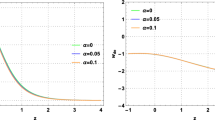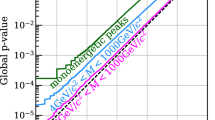Abstract
Realization of the inverted hierarchy is studied in the radiative neutrino mass model with an additional doublet, in which neutrino masses and dark matter could be induced from a common particle. We show that the sufficient baryon number asymmetry is generated through resonant leptogenesis even for the case with rather mild degeneracy among TeV scale right-handed neutrinos. We also discuss the relation between this neutrino mass generation mechanism and low energy experiments for the DM direct search, the neutrinoless double β decay, and so on.





Similar content being viewed by others
Notes
We call this new doublet the inert doublet hereafter, although it has Yukawa couplings with neutrinos.
We note that the λ 5 contribution in this formula for \(M_{\eta}^{2}\) is neglected, since λ 5 is assumed to be sufficiently small.
In this paper we do not assume any flavor symmetry to realize this structure. Thus, the quantum corrections could change it. However, since the assumed neutrino Yukawa couplings are very small, the zero texture of these neutrino Yukawa couplings are expected to be kept in good accuracy after taking account of the quantum effects through the renormalization group equations. Thus, if the values of nonzero neutrino Yukawa couplings at high energy scale are set suitably, the results obtained in this study could be reproduced. The detailed analysis is beyond the scope of the present study and it will be given elsewhere.
It is possible to consider the situation such that three right-handed neutrinos are all degenerate. However, we do not consider this case here since the result can be estimated by using the results of the two cases.
Although the high degeneracy of the right-handed neutrino masses might be explained in this way, the required values for Yukawa couplings in \(\mathcal{L}_{Y}\) should be just assumed in this framework.
In this analysis, we find the solutions by varying (q 1,q 2) only, for simplicity. If we vary other parameters to find solutions simultaneously, the tuning of (q 1,q 2) required here is expected to be much mild.
The leptogenesis for the high mass right-handed neutrinos is possible also in this radiative mass model. In fact, such a possibility has been studied in [37] for the normal hierarchy and a similar result is expected for the inverted hierarchy. We are interested in the features of the TeV scale model here.
The ΔL=2 scattering reaction densities \(\gamma_{N}^{(2)}\) and \(\gamma_{N}^{(13)}\) involve the interference terms for the right-handed neutrinos with tiny mass splittings. Although they are suggested to play a crucial role in [66], its effect might be suppressed due to very small neutrino Yukawa couplings (16) of the lightest right-handed neutrino N 3.
In the analysis of the resonant leptogenesis in [37], the inverse decay has not been taken into account. As the result, the required mass degeneracy for the right-handed neutrinos is underestimated by one order of magnitude there. In that case, however, it is still milder than the usual case.
These formulas are the same as the ones given in the Appendix of [37] except that they are arranged so as to be applicable to the mass spectrum assumed in this paper. Typos and errors are corrected.
References
Y. Fukuda et al. (Super-Kamiokande Collaboration), Phys. Rev. Lett. 81, 1562 (1998)
Q.R. Ahmad et al. (SNO Collaboration), Phys. Rev. Lett. 89, 011301 (2002)
K. Eguchi et al. (KamLAND Collaboration), Phys. Rev. Lett. 90, 021802 (2003)
M.H. Ahn et al. (K2K Collaboration), Phys. Rev. Lett. 90, 041801 (2003)
D.N. Spergel et al. (WMAP Collaboration), Astrophys. J. 148, 175 (2003)
M. Tegmark et al. (SDSS Collaboration), Phys. Rev. D 69, 103501 (2004)
E. Ma, Phys. Rev. D 73, 077301 (2006)
J. Kubo, E. Ma, D. Suematsu, Phys. Lett. B 642, 18 (2006)
J. Kubo, D. Suematsu, Phys. Lett. B 643, 336 (2006)
D. Suematsu, T. Toma, T. Yoshida, Phys. Rev. D 79, 093004 (2009)
D. Suematsu, T. Toma, T. Yoshida, Phys. Rev. D 82, 013012 (2010)
D. Aristizabal Sierra, J. Kubo, D. Restrepo, D. Suematsu, O. Zapata, Phys. Rev. D 79, 013011 (2009)
E. Ma, Ann. Fond. Louis Broglie 31, 285 (2006)
H. Fukuoka, J. Kubo, D. Suematsu, Phys. Lett. B 678, 401 (2009)
D. Suematsu, T. Toma, Nucl. Phys. B 847, 567 (2011)
H. Fukuoka, D. Suematsu, T. Toma, J. Cosmol. Astropart. Phys. 07, 001 (2011)
M. Fukugita, T. Yanagida, Phys. Lett. B 174, 45 (1986)
M. Plümacher, Nucl. Phys. B 530, 207 (1998)
W. Buchmüller, M. Plümacher, Int. J. Mod. Phys. A 15, 5047 (2000)
W. Buchmüller, P. Di Bari, M. Plümacher, Phys. Lett. B 547, 128 (2002)
W. Buchmüller, P. Di Bari, M. Plümacher, Nucl. Phys. B 643, 367 (2002)
W. Buchmüller, P. Di Bari, M. Plümacher, Nucl. Phys. B 665, 445 (2003)
G.F. Giudice, A. Notari, M. Raidal, A. Riotto, A. Struma, Nucl. Phys. B 685, 89 (2004)
W. Buchmüller, R.D. Peccei, T. Yanagida, Annu. Rev. Nucl. Part. Sci. 55, 311 (2005)
D. Suematsu, Eur. Phys. J. C 56, 379 (2008)
H. Higashi, T. Ishima, D. Suematsu, Int. J. Mod. Phys. A 26, 995 (2001)
D. Suematsu, Phys. Rev. D 85, 073008 (2012)
D. Suematsu, Eur. Phys. J. C 72, 1951 (2008)
R. Barbieri, L.J. Hall, V.S. Rychkov, Phys. Rev. D 74, 015007 (2006)
M. Cirelli, N. Fornengo, A. Strumia, Nucl. Phys. B 753, 178 (2006)
L.L. Honorez, E. Nezri, J.F. Oliver, M.H.G. Tytgat, J. Cosmol. Astropart. Phys. 0702, 028 (2007)
Q.-H. Cao, E. Ma, Phys. Rev. D 76, 095011 (2007)
S. Andreas, M.H.G. Tytgat, Q. Swillens, J. Cosmol. Astropart. Phys. 0904, 004 (2009)
E. Nezri, M.H.G. Tytday, G. Vertongen, J. Cosmol. Astropart. Phys. 0904, 014 (2009)
L.L. Honorez, J. Cosmol. Astropart. Phys. 1101, 002 (2011)
T. Hambye, F.-S. Ling, L.L. Honorez, J. Roche, J. High Energy Phys. 07, 090 (2009)
S. Kashiwase, D. Suematsu, Phys. Rev. D 86, 053001 (2012)
K. Abe et al. (T2K Collaboration), Phys. Rev. Lett. 107, 041801 (2011)
Y. Abe et al. (Double Chooz Collaboration), Phys. Rev. Lett. 108, 131801 (2012)
J.K. Ahn et al. (RENO Collaboration), Phys. Rev. Lett. 108, 191802 (2012)
F.E. An et al. (The Daya Bay Collaboration), Phys. Rev. Lett. 108, 171803 (2012)
K. Nakamura et al. (Particle Data Group), J. Phys. G 37, 075021 (2010)
D.V. Forero, M. Tórtola, J. Valle, arXiv:1205.4018
Z. Ahmed et al. (CDMS Collaboration), Phys. Rev. Lett. 102, 011301 (2009)
E. Aprile et al. (XENON100 Collaboration), Phys. Rev. Lett. 105, 131302 (2010)
G. Angloher et al., Astropart. Phys. 31, 270 (2009)
V.N. Lebedenko et al., Phys. Rev. D 80, 052010 (2009)
G. Jungman, M. Kamionkowski, K. Griest, Phys. Rep. 267, 195 (1996)
D. Smith, N. Weiner, Phys. Rev. D 64, 043502 (2001)
Y. Cui, D.E. Marrissey, D. Poland, L. Randall, J. High Energy Phys. 0905, 076 (2009)
C. Arina, F.-S. Ling, M.H.G. Tytgat, J. Cosmol. Astropart. Phys. 0910, 018 (2009)
M.B. Gavela, T. Hambye, D. Hernandez, P. Hernandez, J. High Energy Phys. 0909, 038 (2009)
D.A. Sierra, A. Degee, J.F. Kamenik, J. High Energy Phys. 1207, 135 (2012)
E. Ma, M. Raidal, Phys. Rev. Lett. 87, 011802 (2001)
J. Adam et al. (MEG Collaboration), Nucl. Phys. B 834, 1 (2010)
B. Aubert et al. (BABAR Collaboration), Phys. Rev. Lett. 104, 021802 (2010)
K. Hagiwara, A.D. Martin, D. Nomura, T. Teubner, Phys. Lett. B 649, 173 (2007)
M. Flanz, E.A. Pascos, U. Sarkar, Phys. Lett. B 345, 248 (1995)
L. Covi, E. Roulet, F. Vissani, Phys. Lett. B 384, 169 (1996)
A. Pilaftsis, Phys. Rev. D 56, 5431 (1997)
E. Akhmedov, M. Frigerio, A.Y. Smirnov, J. High Energy Phys. 0309, 021 (2003)
C.H. Albright, S.M. Barr, Phys. Rev. D 69, 073010 (2004)
T. Hambye, J. March-Russell, S.W. West, J. High Energy Phys. 0407, 070 (2004)
A. Pilaftsis, E.J. Underwood, Nucl. Phys. B 692, 303 (2004)
A. Pilaftsis, E.J. Underwood, Phys. Rev. D 72, 113001 (2005)
S. Blanchet, T. Hambye, F.-X. Josse-Michaux, arXiv:0912.3153 [hep-ph]
E. Aprile, arXiv:1206.6288 [astro-ph.IM]
M. Luty, Phys. Rev. D 45, 455 (1992)
M. Plumacher, Nucl. Phys. B 530, 207 (1998)
Acknowledgements
This work is partially supported by a Grant-in-Aid for Scientific Research (C) from Japan Society for Promotion of Science (No. 24540263).
Author information
Authors and Affiliations
Corresponding author
Appendix
Appendix
We summarize the formulas of the reaction density used in the Boltzmann equations [68, 69] for the number density of N 3 and the lepton number asymmetry.Footnote 14 In order to give the expression for the reaction density of the relevant processes, we introduce dimensionless variables
where s is the squared center of mass energy. The reaction density for the decay of N j can be expressed as
where K 1(z) is the modified Bessel function of the second kind.
The reaction density for the scattering process is expressed as
where s min=max[(m a +m b )2,(m i +m j )2] and \(\hat{\sigma}(s)\) is the reduced cross section. In order to give the concrete expression for the reaction density relevant to Eq. (24), we define the following quantities for convenience:
As the lepton number violating scattering processes induced through the N i exchange, we have
for \(\ell_{\alpha}\eta^{\dagger}\rightarrow \bar{\ell}_{\beta}\eta\) and also
for ℓ α ℓ β →ηη. The cross terms has no contribution if the CP phases are assumed to satisfy |sin2(φ 1,2−φ 3)|=1. We adopt this possibility in the numerical analysis, for simplicity. Since another type of the lepton number violating process N i N j →ℓ α ℓ β induced by the η exchange could be suppressed for a small |λ 5|, we can neglect them safely for the value of |λ 5| used in this analysis.
As the lepton number conserving scattering processes which contribute to determine the number density of N 3, we have
for \(N_{i}N_{j} \rightarrow \ell_{\alpha}\bar{\ell}_{\beta}\) which are induced through the η exchange and also
for N i N j →ηη † which are induced through the ℓ α exchange. The cross terms in these reduced cross sections can be neglected if the same assumption is made for the CP phases as Eqs. (A.5) and (A.6).
Rights and permissions
About this article
Cite this article
Kashiwase, S., Suematsu, D. Leptogenesis and dark matter detection in a TeV scale neutrino mass model with inverted mass hierarchy. Eur. Phys. J. C 73, 2484 (2013). https://doi.org/10.1140/epjc/s10052-013-2484-9
Received:
Revised:
Published:
DOI: https://doi.org/10.1140/epjc/s10052-013-2484-9




